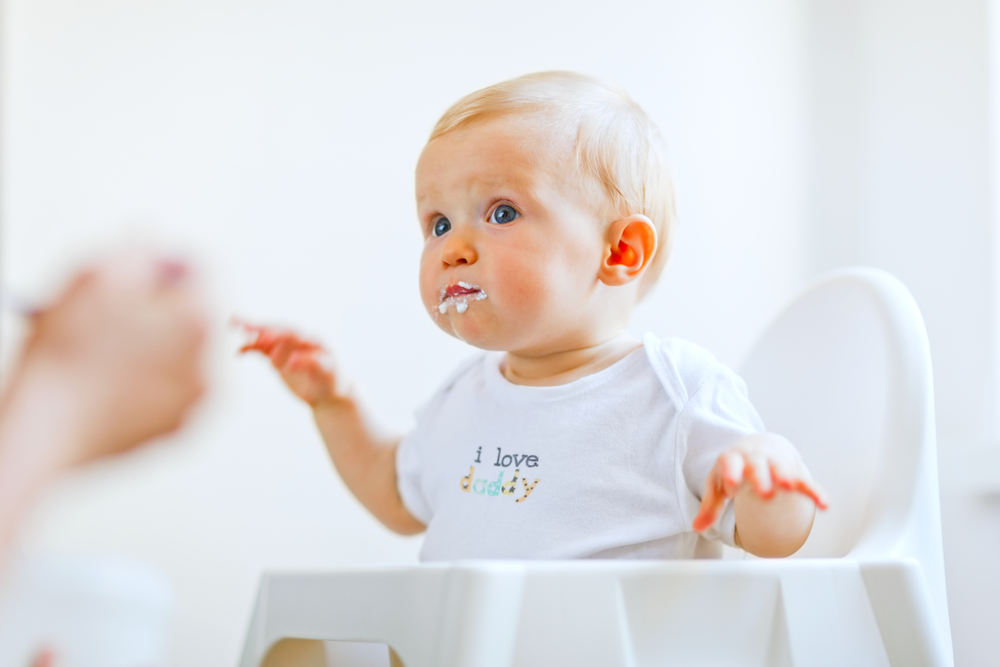The idea of starting solids can be quite daunting – it’s a whole new experience. There has also been some confusion over the last few years about what age, what foods to avoid and so on. Here is a summary and some answers to questions I am frequently asked.
When should I start solids?
It is recommended that solids are started “around” six months (the term “around is fairly vague) but not before four months. In practice this means that sometime from four months (and ideally by six months) you start solids. Be guided by your baby. Signs they are ready include:
- Good head and neck control (obviously essential for safety reasons)
- Showing an interest in food – e.g. reaching/looking with interest/moving their mouth when you eat
- Opens their mouth when offered food
How much solids should I give my baby?
- There is no prescribed amount/frequent and type of food to give your baby. They are all different and having a rigid guideline is likely to cause enormous stress, as babies don’t like following guidelines like we do!
- Basically, start once a day with a teaspoon and work your way up.
- Let your baby guide you. While they are opening their mouth and reaching for more, offer more. Once they start turning their head away/pushing the spoon away, that’s enough and don’t force it. Some days they will eat more than others. Don’t stress in these early phases, food is for fun and to start getting them used to tastes and textures. They still get most of their nutrition from breast milk or formula.
- Trust your intuition and your baby’s signs on this one! It’s amazing how without thinking you find yourself increasing quantities, changing textures and gradually adding extra meals in.
How do I know when to adjust the texture of solids?
- Again, use your baby as a guide. When they are eating a variety of pureed fruit/vegies/meat/legumes easily, start to move on to lumpier/mashed textures rather than puree. At first they may spit these out or even gag a bit, but this is normal.
- Texture introduction is important – if they aren’t exposed to lumpier foods that require a little chewing, they may develop feeding or speech issues later on.
- As a guide: Around 7 months babies can often have coarser, mashed type foods and around 8-9months minced/diced/finger foods can be introduced.
- All babies are different; these ages may be a bit earlier or later depending on how you baby has taken to solids and their oral skills.
- Some babies never really take to being spoon-fed solids – Baby led weaning is becoming more common. Obviously start with softer foods first and always supervise.
What do I need to consider in preparing foods for baby?
- Special tools/”baby” blenders or steamers are not required. Granted some of these gadgets can make life easier, but they are unnecessary and expensive. A normal blender is fine. You don’t need to sterilise, just keep clean with warm soapy water. By this age your baby is putting a lot more than food in their mouth, so sterilisation in unnecessary
- It is not recommended to add in extra salt or sugar
- Obviously check the temperature before offering to your baby. Take care if microwaving foods in particular as the temperature can be inconsistent.
Do I offer milk or food first when starting solids?
- As a general guide – offer milk before solids (e.g. about an hour before) until around 9months of age. At this point, breast milk or formula is still the main source of nutrition. Around about the 9month mark you can start to reverse the pattern and offer foods before milk.
- What you are aiming for is that by 12months, your baby should be getting most of their nutrition from food and milk is an “extra” rather than primary part of their diet.
- For toddlers, avoid giving more than about 500mls of milk (or formula) a day. Toddlers who drink too much cows milk often fill up on that and too much cows milk can lead to iron deficiency.
- It can be tempting to give milk to fussy toddlers to “fill them up” but getting into this habit often creates a bigger problem and you end up in a cycle of food refusal –> giving milk –> child feeling more full –> refusing food.
Should I avoid foods associated with allergy like peanuts when starting solids?
- More evidence is coming to light that in actual fact, earlier introduction of allergenic foods leads to a lower risk of allergy. For this reason, it is recommended that these foods be introduced early and not delayed as was previously recommended. Please discuss this with your doctor if there is a family history of anaphylaxis.
- The most common food allergens are cows milk protein, egg, peanut, tree nut (e.g. cashews), sesame, soy, fish, shellfish and wheat. These cause over 90% of allergic reactions. It is a good idea to introduce these foods well before 12 months, but remember for the purpose of reducing allergy, continued exposure is important– so incorporating these regularly into your meal rotations, not just once off introductions.
- Interestingly, there may also be more risk of allergy from contact via the skin occurring before the mouth (especially in kids with eczema) – so babies smearing peanut butter on themselves before having been introduced to it orally may not be the best idea.
- Ideally, for the purposes of allergy reduction, solids should be introduced while continuing to breastfeed
What are symptoms of food allergy?
These vary in severity from mild to severe and include
o Rashes e.g. hives
o Swelling of the face, lips, tongue
o Tummy pain/vomiting
o Wheezing/stridor (noisy breathing)
o Going pale and floppy
If you are concerned about these symptoms seek urgent medical attention.
If you are concerned about any rashes that may appear after eating various foods, take some photos to help when you see your doctor – as the rash may be gone when you see them (not all rashes in response to certain foods are true “allergy” however).
Is it true that babies cannot have cows milk until 12months?
- This often causes confusion. It is true that babies should not have cows milk as their primary source of nutrition until after 12months. They need breast milk or formula. They can however have cows milk in food products – e.g. yoghurt, custard made on cow milk, cheese, cow milk added to puree etc.
Is there anything I should avoid when starting solids?
- Honey until 12months (risk of botulism)
- Tea/coffee/fruit drinks/soft drink
- Anything that may break off into hard pieces
- Nuts/popcorn or similar that pose a choking risk. Also consider cutting food with tough or chewy skins like grapes/blueberries/sausages into small pieces to reduce the choking risk.
Do I need to use rice cereal first?
No, the traditional rice cereal does not have to be a first food or even used at all. It is easy and high in iron, but also quite bland. It can also be quite constipating due to the high iron content.
What are good sources of iron and when do I need to worry about iron?
- By 6 months baby’s iron stores are starting to fall. This is one important reason why solids need to be introduced at this age. There is very little iron in breast milk or formula.
- Iron can be found in meat and chicken, legumes (e.g. chickpeas/beans), lentils and tofu. Weetbix is also a surprisingly good source.
- Our gut absorbs the iron from plant based foods better when vitamin C is eaten at the same time – so look at including sources of this with these meals (e.g. oranges or other citrus, berries, green leafy vegies or tomatoes).
How do I deal with constipation?
- Once solids have started, some babies do tend to get a bit constipated
- When you introduce solids, also start to offer cooled boiled water to your toddler (e.g. in a sippy cup). This is a good habit to get into and can reduce constipation
- Adding in fruits like pear puree, apricot puree, prune puree can help to avoid constipation.
- Continue breastfeeding if possible, as breast milk also tend to be less constipating than formula.
Is it normal to see food in my baby’s poo?
- Yes. Gone are the days of the innocent breastfed baby poo! It will now likely smell a lot worse and vary according to the foods your baby eats. Don’t be alarmed to see rehydrated sultanas, bits of corn, watermelon that can look like blood, black poo with blueberries and so on.
Where can I find more detailed information to guide us on starting solids:
- Most State Government Health sites have good information
- Here in the Australian Government Department of health site
- The Australasian Society of Clinical Immunology and Allergy (ASCIA) have some good easy to read files about introducing solids, particularly from an allergy perspective.














